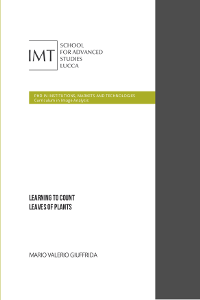Mario Valerio Giuffrida
PhD Thesis (2018)
Mario Valerio Giuffrida (2018) “Learning to Count Leaves of Plants,” PhD Thesis.
Abstract
Plant phenotyping refers to the measurement of plant visual traits. In the past, the collection of such traits has been done manually by plant scientists, which is a tedious, error-prone, and time-consuming task. For this reason, image-based plant phenotyping is used to facilitate the measurement of plant traits with algorithms. However, the lack of robust software to extract reliable phenotyping traits from plant images has created a bottleneck.
Here, we will study the problem of estimating the total number of leaves in plant images. The leaf count is a sought-after plant trait, as it is related to the plant development stage, health, yield potential, and flowering time. Previously, leaf counting was determined using a per-leaf segmentation. The typical approaches for per-leaf segmentation are: (i) image processing to segment leaves, using assumptions and heuristics; or (ii) training a neural network. However, both approaches have drawbacks. Heuristics-based approaches use a set of rules based upon observations that can easily fail. Per-leaf segmentation via neural networks requires fine grained annotated datasets during training, which are hard to obtain. Alternatively, the estimation of the number of leaves in an image can be addressed as a direct regression problem. In this context, the learning of the algorithm is relaxed to the prediction of a single number (the leaf count) and the collection of labelled datasets is easy enough to be also performed by non-experts.
This thesis discusses the first machine learning algorithm for leaf counting for top-view rosette plants. This approach extracted patches from the log-polar representation of the image, allowing us to cancel out leaf rotation. These patches were then used to learn a visual dictionary, which was used to encode the image into a holistic descriptor. As a next step, we developed a shallow neural network to extract rotation-invariant features. Using this architecture, we could learn features to explicitly account for the radial arrangement of leaves in rosette plants. Although the results were promising, the leaf counting with rotation-invariant features could not outperform the previous approach.
For this reason, we moved our attention to deep neural networks. However, it is widely known that deep architectures are hungry of data. Therefore, we addressed the problem of how to collect more labelled plant image datasets, using three approaches: (i) we developed an annotation tool to help experts to annotate images; (ii) we uploaded images in a crowdsourcing online platform, allowing citizen scientists to annotate them; (iii) we used a generative deep neural network to synthesise the images of plants with the leaf count. Lastly, we will show how a deep leaf counting network can be trained with data from different sources and modalities, showing promising results and reducing the performance gap between algorithm and human annotators.

